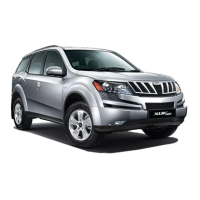Diagnostic Manual - SRS MAN-00081-3
Scorpio mHawk
January 2010/Rev 1
The repair methods given by the manufacturer in this document are based on the technical specifications, current at the time of release. The methods may be
modified as a result of changes introduced by the manufacturer in the production of the various component units and accessories from which the vehicles are
manufactured. The reproduction, translation, transmission, in part of or whole of the present document, are prohibited without the prior written consent of Mahindra &
Mahindra Ltd. The use of this document by any person other than the trained personnel, at the Authoirsed Service Centre of Mahindra & Mahindra Ltd., will amount
to unauthorized use and shall be liable for penalty/prosecution © 2010 Mahindra & Mahindra Ltd.
System Overview
Scorpio is equipped with Passive Safety systems, also known as Supplementary
Restraint System (SRS).The SRS system consists of Driver Airbag (DAB) located
in the Steering Wheel, a Passenger Airbag (PAB) located above the glove box
compartment and seat belt pre-tensioner units on the RH & LH B-Pillars. Airbag
locations can be identified by ‘SRS AIR BAG’ embossed on the air bag module
cover.
The purpose of airbag is to provide additional restraint that is designed to work in
conjunction with seat belts to reduce the severity of injuries to the occupants in
case of frontal collision. The deployment of airbag depends upon the severity and
direction of the frontal collision. This is done by the rapid inflation of a cushion by
non-toxic gas that is generated and/or released by an inflator in response to an
electrical signal from a collision detecting sensor inside the Airbag Control Unit
(ACU). The inflated cushion helps to absorb the energy of the driver or passenger
and prevent body contact with the vehicle structure. The seat belt pre-tensioner
unit removes the slack in the seat belts to avoid the passenger/driver from slipping
through below the belt.
When crash occurs, sensor in the ACU detects the vehicle deceleration and sends
an electrical signal and based on that the ACU decides whether to deploy the
airbag or not. An electrically activated initiator initiates a chemical reaction that
creates gases to fill the airbag. The inflator produces mostly nitrogen gas.

